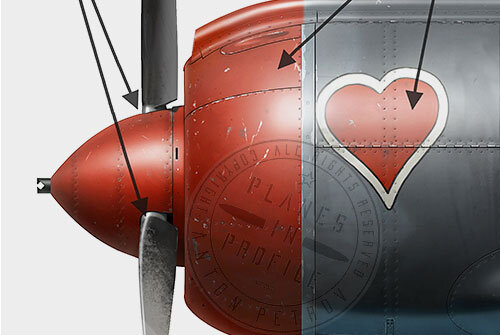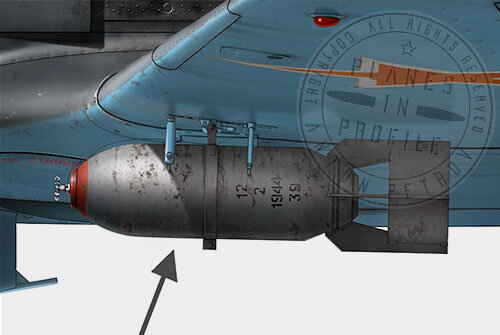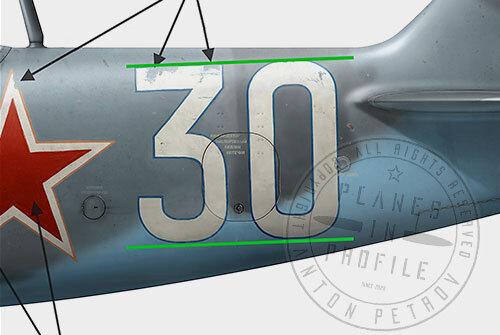Lobanov’s White-30
Lavochkin, La-5FN
41 GIAP (Chernovitskiy) Regiment, 8-th GIAD, 5-th IAK, 2-nd Air Army, 1-st Ukrainian Front, Western Ukraine, circa 1944.
Flown by the Hero of the Soviet Union, Alexandr Vasilievich Lobanov (Soviet Ace with 32 victories (24 personal and 8 shared))
Alexandr Lobanov was appreciated by his comrades not only for his cheerful personality and his ability to entertain them with his accordion music in between air battles, but also for his excellent piloting abilities. In the air, he was a brave fighter pilot, with the courage to plunge his plane in amongst the numerous enemy fighters, or even attack enemy formations head-on. For his bravery and outstanding service during the Kursk battles, Lobanov was awarded USSR’s highest honour- the Hero of the Soviet Union. The website airaces.narod.ru gives an example of a later battle, possibly fought in Lobanov’s-30, in which Lobanov and his wingman Kuznetsov were trying to fight off four Messerschmitts while protecting a damaged Soviet bomber which was flying with only one engine working. After Lobanov shot down one of the enemy planes another four Messerschmitts arrived to join the battle, eventually shooting down Kuznetsov who had to jump out of his plane with a parachute 30 minutes into the battle, leaving Lobanov to fight off 7 enemy fighters and protect the bomber all on his own. The Messerschmitts couldn’t shoot Lobanov’s plane down and Lobanov kept them too preoccupied to be able to finish the bomber. Later the crew of the bomber warmly thanked Lobanov for being there for them and for fighting off the enemy fighters who eventually gave up and left, probably because they ran short on fuel as was often the case.
Though I was unable to find out when exactly A.V. Lobanov received his White-30, it is likely that the battles to take back Chernivtsi (in Ukraine) in March 1944, for which the regiment got its name of ‘Chernovitskiy ’ and was awarded the order of Kutuzov, were fought by Lobanov behind the controls of his La-5FN.
By the end of the war, Lobanov flew 600+ sorties (according to other sources - up to 850), participated in about 85[2] air battles and shot down 24 enemy aircraft personally and 8 (but likely more in 1941-1942) shared [1]. His military career ended in the 1950s, by that time Lobanov held the rank of Lieutenant Colonel.
Noteworthy Visual Characteristics
1. The base of the propeller blades are unpainted.
2. The red engine cowling with the heart are the identification markings of Lobanov’s squadron. The heart is painted over the top the “FN’ logo which usually appears in this area. Not all hearts were painted red, in this photograph http://ava.org.ru/iap/41g/la5fn_white_heart.jpg we can see a plane in the background which has a white heart with a dark (probably red) outline.
3. The shape of the heat panels is that of the early La-5FNs
4. Based on the reference it appears that some of the paint of the star and the number has chipped off in the areas indicated by the arrows. But these might just be damage marks on the photo itself.
5. Lobanov’s-30 appears to be carrying FAB-50 bombs in the photo taken in 1945. http://ava.org.ru/iap/41g/la5fn_lobanov_pavlov.jpg . The exact kind of the bomb is hard to tell from the photograph, but based on the research by Erik Pilawski which can be found here http://www.redbanner.co.uk/History/Archive/bombs-rockets/fab50/fab50.html it appears that bomb that most closely matches what we see in the reference is the FAB-50SCh 1944 http://www.redbanner.co.uk/History/Archive/bombs-rockets/fab50/fab50tsk-paint.jpg . I have used this bomb as reference in my artwork, although I left the bomb unpainted with only the tip of the nose being covered in red, as interpreted from the photo reference.
6. Note the arrangement of the antenna wires. This can be confirmed by the reference photo http://ava.org.ru/iap/41g/la5fn_white_heart.jpg in which Lobanov’s-30 is being serviced. The antenna wires are just barely visible on the left hand side of the photo.
7. Lobanov's-30 bears a roughly painted image of a vulture on the left side of the plane. It was probably painted in white, straight over the grey background. Note, the tip of the bird’s wing extends onto the moving part of the canopy. Reference for this can be found here http://ava.org.ru/iap/41g/la5fn_30_lobanov.jpg
8. The outline of the star appears to be lighter than the red interior of the star. For a while I assumed that the outline must be yellow, but yellow is a very non-standard colour to use for the thin outline of the stars. After having discussed this with others and having given it more thought I believe that the explanation for the lighter outline could be the fact that it is faded, while the interior of the star has been repainted with fresher paint. Infact, not just the outline, but the whole plane appears to be slightly "faded/light" , while the interior of the star appears quite dark. The dark interior of the star could just have newer/fresher red paint while the colour of the rest of the plane, including the star’s outline’ is slightly faded. http://ava.org.ru/iap/41g/la5fn_30_lobanov.jpg
9. The cowl bands were painted. The paint on them started to chip off exposing the bare metal underneath.
10. The serial number of this plane in not known to me. The plane was most likely build at factory 21 where an overwhelming majority (almost all) of La-5FNs were built, meaning that the serial number would have been 3921(followed by the unknown series number)30. Because I don’t know the series number of this plane, I have painted the serial number rather faintly with the digits of the series number mostly rubber off in an attempt to create the most truthful compromise. (If you have more info about the serial number of this plane then please let me know in the comments below).
11. In the same photograph from 1945 as the one in point #4, it appears that the top part of the gear strut shield was painted in a darker colour (on both sides of the plane?). Based on the tone of the colour it looks like it matches the red of the engine cowling, the heart and the tip of the bomb, but it seems random that it would be painted red. I think it's more likely that it was a darker blue colour possibly, maybe the colour that was used for the outline of the tactical number. It would seem more appropriate to use it over the top of AMT-7 (light blue), if this was some sort of a repair job for example.
12. Note the deep dents in the parts indicated by the arrows. The dent on the red part of the engine cowling is what helped to identify the plane in the photo where we mentioned the antenna, as Lobanov’s-30. Reference for the dents is here http://ava.org.ru/iap/41g/la5fn_lobanov.jpg
13. On Patreon
Here are a few closeup images to help illustrate the points above. Full set of closeup images is On Patreon
FOOTNOTES
[1] Info about the number of sorties and kills is taken from Mikhail Bykov’s book called ‘Все Асы Сталина’ (All of Stalin’s Aces), page 702. Youza-press, 2014.
[2] M.Bykov’s book doesn’t mention the number of air battles that Lobanov engaged in, the info about the number of air battles is taken from this web page http://soviet-aces-1936-53.ru/abc/l/lobanov_av.htm
More info about the 41GIAP (which was 40 IAP before 8 February, 1943, and became 712-nd GIAP after 20 February 1949) can be found here
http://ava.org.ru/iap/41g.htm?fbclid=IwAR0VUxHOosVM9VWM4naY0yh1LurbPHnKaZNIWRz96cmQx95lGWF7Lh0h1Oc
and here:
https://ru.wikipedia.org/wiki/41-%D0%B9_%D0%B3%D0%B2%D0%B0%D1%80%D0%B4%D0%B5%D0%B9%D1%81%D0%BA%D0%B8%D0%B9_%D0%B8%D1%81%D1%82%D1%80%D0%B5%D0%B1%D0%B8%D1%82%D0%B5%D0%BB%D1%8C%D0%BD%D1%8B%D0%B9_%D0%B0%D0%B2%D0%B8%D0%B0%D1%86%D0%B8%D0%BE%D0%BD%D0%BD%D1%8B%D0%B9_%D0%BF%D0%BE%D0%BB%D0%BA
LINKS TO THE REFERENCE Images and videos
http://ava.org.ru/iap/41g/la5fn_white_heart.jpg
http://ava.org.ru/iap/41g/la5fn_lobanov_pavlov.jpg
http://ava.org.ru/iap/41g/la5fn_30_lobanov.jpg
http://ava.org.ru/iap/41g/la5fn_lobanov.jpg
Based on the position of the heart it is very likely that the images in the links below might also be Lobanov’s ‘White-30’
https://www.polkrf.ru/files/veteran/pics/36/36697.jpg
https://forum.il2sturmovik.com/uploads/monthly_12_2017/post-102894-0-47628600-1514579268.jpg
All the work presented on this is page is subject to updates and revisions in the light of new information which might present itself. If you have any new information relevant to this page or disagree with anything that's presented here, then please feel free to contact me through the Planes in Profile Facebook page. Thanks:)





